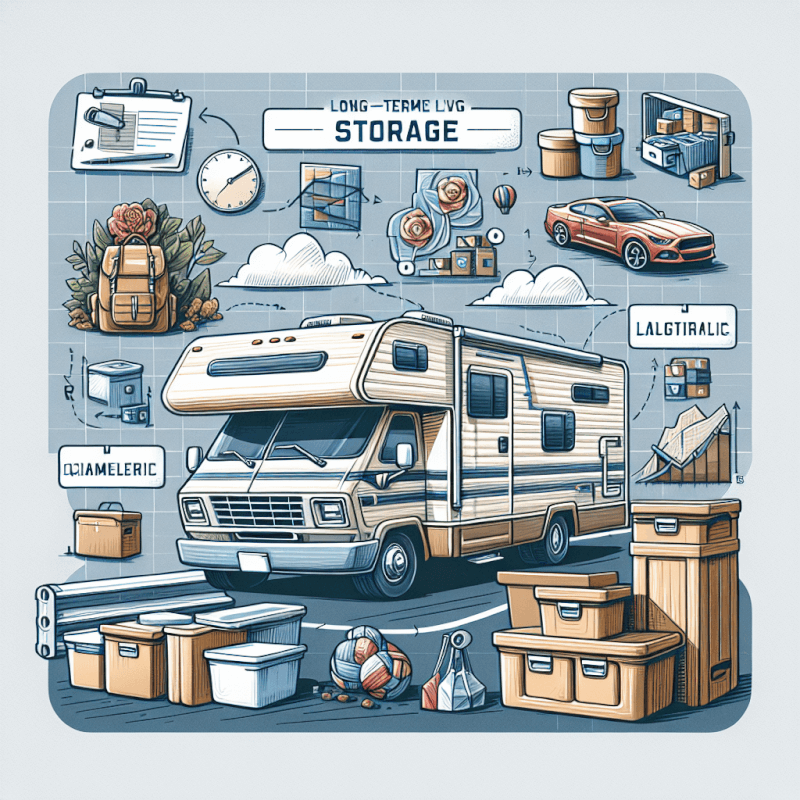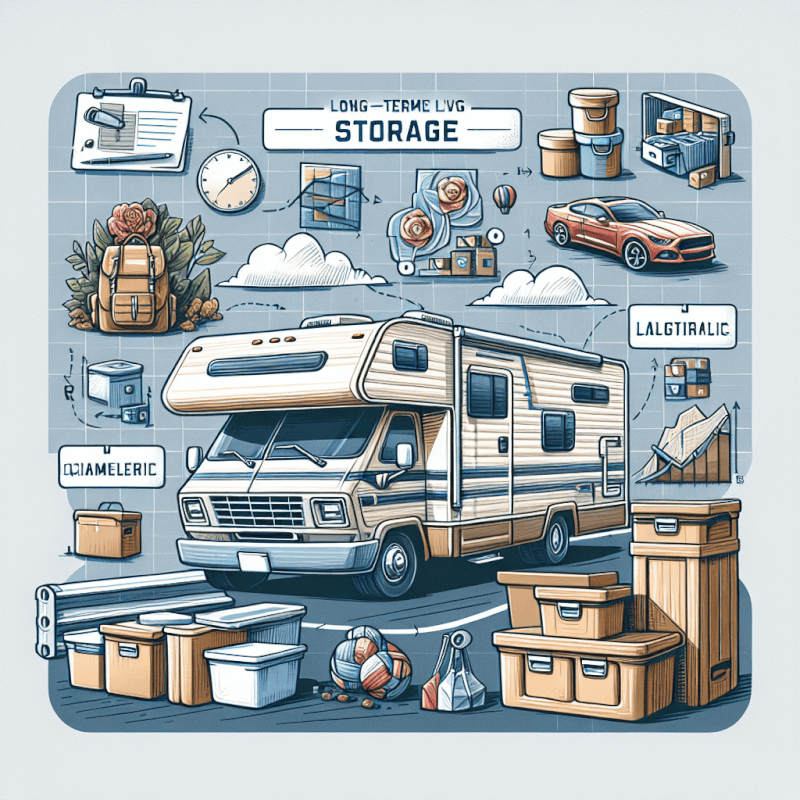Traveling full-time in an RV can be an exciting and fulfilling adventure, but what about all your belongings that don’t fit inside your mobile home? Finding a solution for long-term storage can seem daunting, but fear not! In this article, we will explore various strategies and tips to help you effectively handle the storage of your belongings while embarking on your RVing journey. Whether it’s sentimental items, seasonal gear, or simply decluttering, we’ve got you covered with our friendly advice. So, let’s dive in and discover the best ways to keep your belongings safe and sound while living life on the road!

Choosing the Right Storage Facility
When it comes to choosing the right storage facility for your belongings while RVing full-time, there are a few factors you should consider. Firstly, take a look at the facility’s security measures. You want to ensure that your items will be safe and protected while in storage. Look for facilities that have 24/7 surveillance cameras, secure locks, and even on-site security personnel.
Another important consideration is climate control. RVing often means traveling to various climates and weather conditions, so it’s crucial to find a storage facility that offers climate-controlled options. This will help prevent damage to your belongings from extreme temperatures, humidity, or moisture.
Accessibility and convenience are also key factors to think about. Look for a storage facility that is conveniently located near your current or frequent RVing destinations. Additionally, check the facility’s accessibility hours to ensure that you will have convenient access whenever you need to retrieve or store items.
Lastly, compare prices and storage unit sizes. Different storage facilities offer various unit sizes, so make sure you choose one that will accommodate all your belongings. Furthermore, compare prices to ensure you are getting the best value for your money. Take into account any available discounts or promotions that might be offered by the storage facility.
Sorting and Organizing Belongings
Before storing your belongings, it’s essential to sort and organize them effectively. This will save you time and effort when you need to locate specific items. Start by creating an inventory of all your belongings. This can be done through a written list or a digital spreadsheet. Take note of each item and its condition to keep track of everything.
Categorize your items based on their frequency of use. Group together the things you will need more often and place them in easily accessible spots in your storage unit. This way, you won’t have to dig through boxes to find the items you use frequently.
Label and document your boxes to make it easier to locate specific items. Use detailed descriptions and consider color-coding your labels for even more convenience. Additionally, take photos of the contents of each box and keep a digital record. This will serve as a visual reference and help you find things quickly.
To protect your belongings while in storage, use appropriate packaging materials. For fragile items, such as glassware or electronics, use bubble wrap or packing peanuts. Wrap delicate items individually to prevent them from scratching or breaking during transit or while in storage. Sturdy boxes and packing tape will help keep everything secure and organized.
Preparing Items for Storage
Before placing your items in storage, it’s important to prepare them properly for their stay. Start by thoroughly cleaning and sanitizing all of your belongings. This will help prevent any mold or mildew growth and keep everything fresh. Make sure to dry items completely to avoid moisture damage.
Consider dismantling larger items, such as furniture or appliances, if possible. This will save space and make it easier to pack them into your storage unit. Keep any screws or small parts in labeled bags and attach them securely to the corresponding item. This way, you won’t have to search for missing parts when you need to use the item again.
For delicate and fragile belongings, take extra precautions to protect them. Wrap them in soft materials, such as blankets or towels, before placing them in a box. Fill any gaps with bubble wrap or packing paper to prevent movement and cushion the items. Additionally, consider storing these items in a separate area of your storage unit to minimize the chances of damage.
When it comes to storing electronic devices, take special care. Remove any batteries and consider storing them separately to prevent corrosion. If possible, pack the devices in their original packaging or use anti-static bags to protect them from static electricity. Finally, avoid placing heavy items on top of electronics to prevent any potential damage.
Securing Your Storage Unit
Ensuring the security of your storage unit is crucial for peace of mind. When choosing a lock, opt for a high-quality one that is resistant to cutting or picking. It’s worth investing in a reliable lock that will provide an added layer of protection for your belongings.
Consider additional security measures for your storage unit. Some storage facilities offer video surveillance, individual unit alarms, or even gated access codes. These extra layers of security can deter potential theft and provide an added sense of security.
A well-lit storage unit is also important. Bright lighting can deter criminals and make it easier for you to see and retrieve your belongings. If the storage facility doesn’t have adequate lighting, consider adding battery-operated motion sensor lights in your unit for better visibility.
It’s important to inform the storage facility if you will be absent for an extended period. Provide them with your contact information and let them know when you expect to return. In the event of an emergency or any issues with your storage unit, they will be able to reach you.

Managing Documents and Valuables
While RVing full-time, you may still have important documents and valuable items that need to be stored securely. Keep important documents, such as passports, birth certificates, and insurance policies, in a safe place. Consider investing in a portable document safe or a lockable file box to keep them protected.
For added protection, consider using a fireproof and waterproof container for your important documents. In the event of a fire or water damage, this will ensure that your documents remain unharmed. Make sure to securely seal the container to limit exposure to external elements.
It’s also a good idea to digitize your important documents as a backup. Scan them and save them on a secure cloud storage platform or on an external hard drive. This way, even if the physical copies are lost or damaged, you will still have access to the digital versions.
Take inventory of your valuable items, such as jewelry, collectibles, or expensive electronics. Keep a detailed record of each item, including descriptions, purchase dates, and their estimated value. Take photos or videos of these items as further evidence in case you need to make an insurance claim in the future.
Maintaining Storage Unit Organization
A well-organized storage unit will ensure that you can easily find and retrieve your belongings whenever needed. Visit the storage unit periodically to check on everything and make any necessary adjustments. This will help you stay on top of the organization and prevent any issues from arising.
To avoid damage to your belongings, rotate them periodically. This means moving the items in the front of the unit to the back and vice versa. This will help prevent any one area from being constantly loaded or exposed and distribute any potential wear and tear more evenly.
Label and update the storage unit layout as needed. As you access your storage unit or add new items, label the boxes or shelves accordingly. This will make it easier to locate specific items and ensure that everything is in its proper place.
Consider using shelves or storage racks to maximize the use of space and improve organization. These can help keep your belongings off the floor and provide easy access to items stacked higher up. Utilize different shelving units for different categories of items, making it easier to find what you need.

Protecting Belongings from Pests
Pests can pose a significant threat to your stored belongings. To prevent infestations, seal any gaps and cracks in your storage unit. Use caulk or weatherstripping to seal any potential entry points for pests, such as doors, windows, or vents.
Avoid storing food items in your storage unit. Even non-perishable foods can attract pests and lead to infestations. Opt for airtight containers for any non-perishable food items that you may need to store temporarily.
Implement pest control measures to further protect your belongings. This can include placing pest traps or using insect-repellent products within your storage unit. Regularly check and replace any traps or repellents to ensure their effectiveness.
Consider using natural repellents, such as cedar chips or lavender sachets, to deter pests. These natural options can help keep pests away without the use of harmful chemicals. Place them strategically throughout your storage unit to create a barrier against pests.
Insurance for Stored Belongings
Insurance is an essential consideration when storing your belongings. Check if your RV insurance covers storage and if it provides adequate coverage. Some policies may have limitations or exclusions when it comes to storage units. Review your policy carefully or contact your insurance provider for more information.
Consider obtaining separate storage insurance for added peace of mind. Storage insurance is specifically designed to cover items while they are stored away from your RV. It often offers more comprehensive coverage and can help protect you financially in the event of damage, theft, or natural disasters.
Before selecting a storage insurance policy, it’s important to understand the coverage and exclusions. Read the policy documents carefully and ask any questions regarding coverage limits, deductibles, and specific conditions that may affect your coverage. Make sure the policy aligns with your needs and provides sufficient protection.
To further protect your belongings, take photos or videos of valuable items before storing them. This visual evidence can be helpful if you need to make an insurance claim. Store the photos or videos in a digital format that can be easily accessed if necessary.

Managing Payments and Renewals
To avoid any disruptions or late fees, set up autopay for your storage unit fees. This will ensure that your payments are made promptly and automatically, saving you time and preventing any accidental missed payments. It’s also important to keep track of payment due dates to ensure that your storage unit remains accessible and protected.
When planning for long-term storage expenses, consider including storage unit fees in your budget. Evaluate the costs and factor them into your monthly or yearly expenses. If necessary, set aside a dedicated savings account or create a separate category in your budget specifically for storage expenses.
If there are any changes to your contact information or circumstances, notify the storage facility promptly. Update your contact details to ensure that the facility can reach you if needed. Additionally, inform them about any changes in your storage needs, such as downsizing or requiring additional space.
Preparing for Retrieval of Belongings
When the time comes to retrieve your stored belongings, proper preparation is key. Start by updating your contact information with the storage facility. Provide them with your current phone number, email address, and any other relevant details. This will ensure a smooth communication process and make it easier for them to reach you.
Make arrangements for access to your storage unit upon your return. Check the facility’s policies regarding access and make sure you know how to retrieve your belongings. Some facilities may require advance notice or have specific procedures, so it’s essential to familiarize yourself with these requirements beforehand.
Before retrieving your belongings, check the condition of your storage unit. Look for any signs of damage, water leaks, or pests. Take note of any issues and report them to the storage facility immediately. This will help ensure that any necessary repairs or pest control measures are taken care of promptly.
Prepare the necessary tools for moving your items out of storage. Depending on the size and weight of your belongings, you may need dollies, hand trucks, or furniture sliders. Having the right tools on hand will make the retrieval process easier and help protect both your belongings and yourself from any potential injuries.
Handling long-term storage of your belongings while RVing full-time requires careful planning and organization. By choosing the right storage facility, sorting and organizing your belongings effectively, preparing them appropriately for storage, and ensuring proper security measures, you can have peace of mind knowing your belongings are safely stored. With proper management, insurance coverage, and careful preparation for retrieval, you can enjoy your RVing adventures while knowing your possessions are protected and ready for whenever you may need them.



